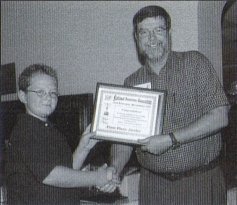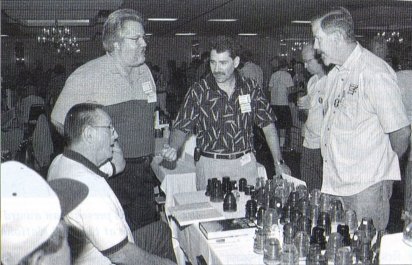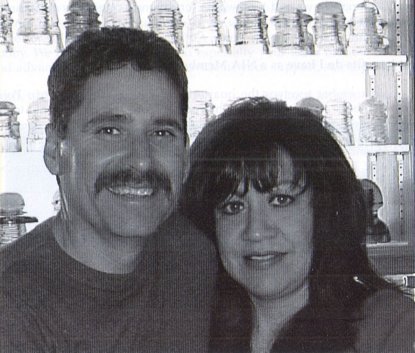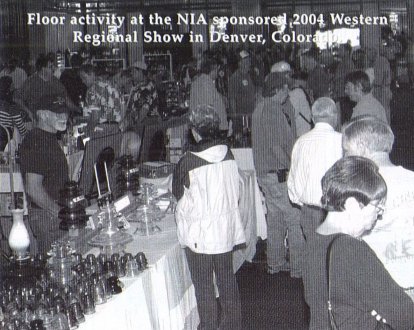What is the NIA and how did it get started?
The mission of the National Insulator Association (NIA) is to encourage
growth and public awareness of the insulator hobby through collecting, dealing,
and education. Additionally, to protect the interests of all insulator
collectors and dealers by establishing standards and ethics by which insulator
collectors and dealers may fairly deal with one another. To accomplish this mission the NIA needs the support of all collectors and clubs. We need your
physical help to serve on committees; we need your ideas and your monetary
support through membership dues.

President Ellis presents an award to
Clay Bledsoe at the 2004 National.
The first national insulator show of significance was held in the Smith
Auditorium in New Castle, Indiana on June 20, 1970. In the following years
national shows were held in Colorado Springs in 1971, Kansas City in 1972 and
Hutchinson, Kansas in 1973. These shows were not the product of the NIA. To the
contrary, the NIA was a product of those shows, the enthusiastic collectors who
organized and supported them and those collectors who felt an overwhelming
desire to see collectors unite for the common cause of advancing the insulator
collecting hobby.
The discussions for a national organization began at the Colorado Springs
show in 1971. Throughout the following year, discussions took place between
collectors who had hopes of forming a national organization at the Kansas City
Show in 1972. To some collector's dismay, 1972 would not be the year. The late
night discussions at the Kansas City show did however lead to an Organizing
Committee chaired by Warren Olsen. The other committee appointees were Ernest
Rostock, Pendleton, OR; Larry Harmon, Wentzville, MO; Fred Griffin, Palatka, FL;
John Hall, Columbus, OH; Steve Freedman, Wallingford, CT; Chuck Henry,
Bakersfield, CA; and .Rodney Wing, Garden City, MI. John Hall took the lead in
writing the proposed bylaws and produced a number of drafts which were reviewed
and debated by the committee.
The NIA was born at the Hutchinson, Kansas show after the Saturday night
banquet on July 7, 1973 when the group of collectors in attendance approved the
Bylaws presented by Mr. Olsen's Organizing Committee. That night elections were
held and dues were collected. The first President was Fred Griffin. Steve
Freedman, Jesse Moreland, and Richard Augustyn were elected to the Board of
Directors. The Organizing Committee Chairman, Warren Olsen, had the honor of receiving membership number one.
The major goals of the young organization were to encourage the growth of the
insulator collecting hobby and to provide for a large National Insulator Show
that would be rotated throughout the various regions of the United States. Since
these early days the NIA has evolved along with the hobby to its current day
structure and stated mission.

Action on the floor of the 2004 National in Pittsburgh, PA.
What is the governing structure of the NIA?
The NIA was incorporated in 1999 due to growing concerns about liability and
other legal issues. The NIA was registered as a non-profit corporation in
Arizona, on July 22, 1999. The governing body of the NIA is made up of ten Board
members. The Board has approved nine standing committees to assist in
accomplishing the mission the NIA.
The Board is made up of the President who is elected by all NIA members. The
two most recent Past Presidents serve on the Board to help establish continuity
between previous and current administrations and to provide additional expertise
to the Board. There are three Region Vice Presidents. Each represents one of the
three regions across the United States, Canada and other parts of the world. The
Vice Presidents are elected by NIA members in their respective region. They
represent the constituents in their region on the Board. The Vice Presidents
also have the responsibility to encourage insulator shows within their region.
The President, with advice and consent of the Vice Presidents, appoints an
Executive Secretary, to maintain the Corporation's records and other official
documents, take and publish Board and General Membership meeting minutes and
solicit bids for the National and Region shows.
A Treasurer is appointed by the President, with advice and consent of the
Vice Presidents, to handle all the financial affairs of the organization and to
file the annual corporate reports. Additionally, the position coordinates the
show liability insurance program.
The Information Director, with the advice and consent of the Vice Presidents,
is appointed by the President and coordinates the information and publication
services of the NIA. One of the main functions of the Information Director is to
publish, quarterly, the official NIA publication the Drip Points.
The Membership Director is also appointed by the President with the advice
and consent of the Vice Presidents. The Membership Director handles all the
membership services for the NIA.
The current Board members are Dudley Ellis, President; Tom Katonak, First
Past President; Steve Marks, Second Past President; Larry Novak, Eastern Region
Vice President; Ed Peters, Central Region Vice President; Howard Banks, Western
Region Vice President; Glenn Drummond, Executive Secretary; Jack Roach,
Treasurer; Kevin Jacobson, Information Director; and Joe Beres, Membership
Director. The contact information for the Board can be found on the NIA web page
at www.nia.org or in the Crown Jewels of the Wire Subscribers and National
Insulator Association Membership Directory. If you have neither of these you may
call me at (770) 957-9928 and I will help you contact the right person.
What are the NIA Committees doing for the hobby?
As incoming President, I selected various committee chairpersons, with Board
approval, to accomplish the goals of the NIA. The committees will continue with
ongoing projects and incorporate the new administration's goals into their work
plans for the next two years. When I took over as NIA President I set new goals
for each of the committees in addition to specific projects requested by the
Board. My major goal for the committees in general is to increase the committee
members of each committee. My reasoning for this is to involve more collectors
in the hobby and the operation of the NIA and thus have the benefit of more
ideas within each committee.
Within the last few years the Board created the Promotions Committee to
develop ideas and initiate programs to promote our hobby. The committee is
finalizing a DVD for the promotion of the insulator collecting hobby. The DVD
can be used by clubs and individual collectors in presentations made to school
classes and professional organizations and can be given to the various news
media for their use to promote our hobby. The professional movie will provide
insulator history, collecting history and clips from insulator events. I also
have asked this committee to place emphasis on developing youth oriented
programs to get more youth interested in the hobby. Additionally, I have asked
the committee to develop press packets to be used by the hobby to send to local
newspapers and television and radio stations. Bob Merzoian, the Committee Chair,
is looking for committee members to help in these endeavors. The NIA needs your
talents in this area.
I have asked Jacque Linscott Barnes, Nominations Committee Chairman, to establish a list of collectors willing to serve the NIA. She has developed a
committee with two members from each region to recruit hobbyists within their
respective region to run for NIA officers or to serve the NIA in other
capacities. Please say yes when you are approached by the committee and let
them know how you are willing to serve.
The Bylaws Committee, chaired by Bob Stahr has been charged with reviewing
the minutes from previous Board meetings to be sure that all rule changes by the
Board have been included in the NIA Handbook. Additionally, I have asked the
committee to review the entire handbook for potential changes. This review would
include show standards and show rules. I have asked the committee to coordinate
suggestions in these areas with the new ad hoc committee the Board has approved
to review insulator show related issues. I will write more about this committee
later.
Charles Bibb, the Ethics Committee Chairman, deals with ethical issues
confronting the hobby. Charles is good about being discreet. If you have an
ethical issue relating to a NIA member you can be confidant that Charles will
work with you.
The Historical Committee, Chaired by Rick Soller, maintains an archive
documenting the history of the NIA and the insulator-collecting hobby. The
Committee is actively inventorying and adding the contents of the archive to the
NIA web page. If there are documents or items in the archive that you would like
to review please call Rick for arrangements. Additionally the Committee has
ongoing museums projects. Rick has spent time with museums in Claremont, lA,
Oshkosh, WI, and the Westinghouse Museum in Pittsburgh in the Committee's
ongoing efforts to promote the NIA as a source of help and information for these
museums.
Carolyn Berry is the Product Marketing Committee Chair. The committee
develops and markets products that promote our hobby and the NIA. Some new and
improved items are available including etched glass beer mugs with the NIA
logo. NIA badges, service bars, shirts, hats and other products are available
for nominal cost from the Committee. Pictures of the products, prices and an
order form are available from the NIA web page.
The Research and Education Committee is chaired by Bob Berry. The Committee's
charge is to actively conduct new areas of research, and publish that
information to educate collectors and the general public about the insulator
collecting hobby through various means (including maintaining the NIA's Internet
website). Lately, most of the Committee's time has been spent on updating the
NIA's website www.nia.org . Bob reports that traffic to the website is steadily
increasing. This year, the Committee will start posting back issues of Drip
Points on line for people to view. The Committee is developing a search feature
on the web page to search for old insulator articles in Crown Jewels, Cross
Arms, and Old Bottle Magazines. The Committee will continue to add items to the
website and is looking for input from the membership.
John McDougald is the Chair of the Authentication & Classification
Committee. The Committee deals with the authentication of insulators and related
items and from time to time deals with standards issues. The five member committee is moving forward with their review of suspect insulators.
During the past year, the Committee has been very instrumental in identifying
and exposing fake and altered insulators to the hobby. One of the committee
goals is to continue to seek a more accurate test for glass that will give a
more definitive answer to glass components and age. Another goal is to better
educate collectors on the identification of fake and altered insulators, so that
they can make a better purchasing decision.
The Awards and Recognition Committee is chaired by Bill Meier. It is
comprised of the following seven members: The Awards and Recognition Committee
Chairperson, the three Regional Vice-Presidents in office immediately prior to
the National Convention, and three at-large representatives, one from each
region, to be appointed annually by the current Awards and Recognition Committee
Chairperson. The Committee prepares and furnishes awards for NIA Sanctioned and
NIA Sponsored Shows. Additionally, they make recommendations to the Board for
NIA Lifetime Memberships and Outstanding Service Awards. The Committee has been
asked by the Board to review the NIA Exhibit and Judging Rules and make
recommendations for revisions.

Dwayne and Ofelia Anthony this year received the highest honor awarded by the
National Insulator Association... Lifetime Membership. The award recognizes
lengthy dedication and service to the NIA and to the hobby as a whole. It is
generally awarded to couples with the knowledge that dedication from one spouse
is dependent upon support from the other.
Over the last few years I have read comments on ICON and have been involved
in many discussions relative to insulator shows. Some of the comments involved
region boundaries, traveling too far to shows, lack of support for some shows by
dealers, displayers and attendees, lack of show host interest, shows need more
support from the NIA and the list goes on. The Board and I have heard you and we
want to work on these issues. The Board has established an ad hoc committee to
study these show related issues and make recommendations to the Board for their
resolve.
How does the NIA support shows?
The National Convention show hosts may
receive up to $500 for show advertising.
The NIA Region show hosts may receive up to $250 for show advertising.
Shows sponsored by an NIA member or by a member club can take advantage of
NIA liability insurance coverage at reduced rates of $50 per show day.
The NIA supports insulator shows by providing a complementary "Best of
show" ribbon for displays at local shows, a "Best of Show" plaque
for sanctioned Regional shows and ten awards for different categories at the
annual National show.
What benefits do I have as a NIA Member?
Each paid member receives the quarterly NIA newsletter the Drip Points. Board
Members and Committee Chairpersons use the Drip Points to give members updates
on their committee and other hobby issues.
A NIA member is entitled to attend the official NIA day at the National
Convention. This allows you to shop a full day at the show before nonmembers.
New members receive a copy of the NIA By-laws and Code of Ethics as well as
a window decal.
Each member may choose to be listed in the annual Crown Jewels of the Wire
Subscribers and National Association Membership Directory.
NIA members receive a discount coupon each year towards a yearly Crown Jewel
of the Wire subscription.
NIA members can purchase collectors insurance through NIA sponsored insurance
programs.
Show hosts who are NIA members may purchase show liability insurance at
reduced rates.
The NIA Historian maintains a large library of insulator documentation that
can be queried by NIA members for research and education.
Why should I join the NIA?
Several years ago I went insulator hunting one Saturday morning with some
friends. When we stepped out of our vehicles it was eighteen degrees with a
light breeze. That is cold here in Georgia. The following Saturday some of us
went on another insulator hunt. This time it had warmed up to twenty eight
degrees but it was spitting snow and the wind was blowing twenty five mile per
hour. I was asked by one of my freezing friends why we were out in this kind of
weather. My quick response was that we were paying our dues to the hobby. Well,
it sounded pretty good and we went on with our hunt. I sometimes think about
those mornings and that profound remark and think about how right I may have
been.
Whether we go on an insulator hunt, volunteer to be an officer in our club,
host a show, go to a swap, agree to be part of a committee to improve the hobby,
aren't we really paying our dues to the hobby that we love? I have held three
positions in the Dixie Jewels Insulator Club, chaired a NIA Committee and held
two positions on the NIA Board. Sure I get some gratification from doing these
things but most of all I feel like I am paying my dues to my hobby.
The NIA needs the support of each one of you who reads this article. You can
help the NIA in some way even if it is just by paying your $12 annual membership
dues. If you feel so inclined we would love to have you join a committee or
volunteer to run for an NIA office. You can make a difference in our hobby. We
need your support and especially your ideas on how to improve and advance our
hobby. Please provide us your support, starting today!
Dudley Ellis, President
National Insulator Association



































































